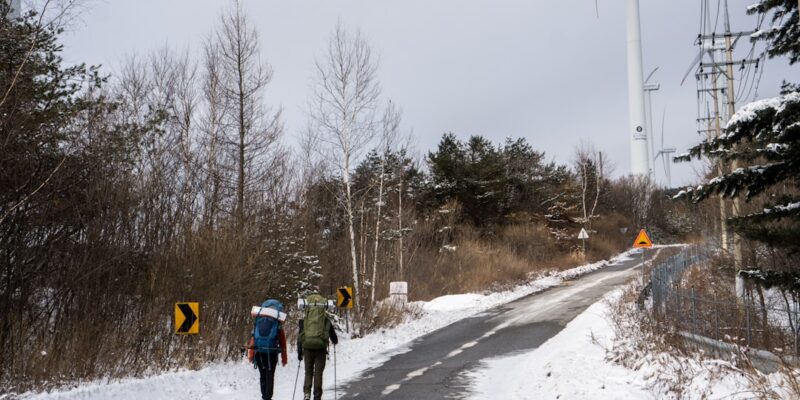
Sleep Tight: Packing Your Sleeping Bag for a Hiking Trip
Choosing the right sleeping bag for a hiking trip is crucial for a comfortable and restful night’s sleep. A good sleeping bag can make all the difference in ensuring that you stay warm and cozy throughout the night, even in the most challenging outdoor conditions. In this blog post, we will explore the various factors to consider when choosing a sleeping bag, including temperature ratings, materials, shape and size, packing methods, sleeping bag liners, care and maintenance, and accessories. By understanding these factors and making informed decisions, you can find the perfect sleeping bag that meets your specific needs and enhances your overall hiking experience.
Key Takeaways
- Choose a sleeping bag that suits your hiking trip’s conditions and your personal preferences.
- Understand temperature ratings and choose a sleeping bag that can keep you warm in the expected temperature range.
- Synthetic sleeping bags are more affordable and easier to maintain, while down sleeping bags are lighter and more compressible.
- Consider the shape and size of your sleeping bag to ensure comfort and warmth.
- Compression sacks are better for packing your sleeping bag, while stuff sacks are more convenient for quick access.
- Sleeping bag liners can add warmth, hygiene, and comfort to your sleeping setup.
- Keep your sleeping bag dry and clean by using a waterproof stuff sack, airing it out regularly, and washing it properly.
- Choose a sleeping pad that matches your sleeping style and provides enough insulation and cushioning.
- Sleeping bag accessories like pillows, eye masks, and earplugs can enhance your comfort and sleep quality.
- Store your sleeping bag properly by keeping it dry, clean, and uncompressed, and avoiding direct sunlight and moisture.
Choosing the Right Sleeping Bag for Your Hiking Trip
When choosing a sleeping bag for your hiking trip, there are several factors to consider. First and foremost is the temperature rating of the sleeping bag. Temperature ratings indicate the lowest temperature at which a sleeping bag will keep you warm. It is important to choose a sleeping bag with a temperature rating appropriate for the conditions you will be facing on your trip. Other factors to consider include weight, packability, insulation type (synthetic or down), shape and size, and price.
There are several types of sleeping bags available on the market. The most common types include rectangular sleeping bags, mummy sleeping bags, and semi-rectangular or hybrid sleeping bags. Rectangular sleeping bags offer more room to move around but may not provide as much warmth as mummy bags. Mummy bags are more form-fitting and provide better insulation but can feel restrictive to some people. Hybrid bags offer a compromise between the two styles.
Understanding Sleeping Bag Temperature Ratings
Sleeping bag temperature ratings can be confusing for many people. It is important to understand what these ratings mean in order to choose the right sleeping bag for your trip. Temperature ratings are typically given in three categories: comfort rating, lower limit rating, and extreme rating.
The comfort rating indicates the lowest temperature at which an average person can sleep comfortably in the bag. The lower limit rating indicates the lowest temperature at which a person can sleep in the bag without feeling cold. The extreme rating indicates the lowest temperature at which a person can survive in the bag, although they may experience extreme discomfort and risk hypothermia.
When choosing a sleeping bag, it is important to consider the lowest temperature you expect to encounter on your trip and choose a bag with a temperature rating that is lower than that. It is also important to consider your personal tolerance to cold and whether you tend to sleep warm or cold.
Synthetic vs. Down Sleeping Bags: Which is Right for You?
| Feature | Synthetic Sleeping Bags | Down Sleeping Bags |
|---|---|---|
| Weight | Heavier | Lighter |
| Warmth | Less Warm | More Warm |
| Price | Less Expensive | More Expensive |
| Water Resistance | More Resistant | Less Resistant |
| Compressibility | Less Compressible | More Compressible |
When it comes to insulation, there are two main types of sleeping bags: synthetic and down. Synthetic sleeping bags are made from man-made materials such as polyester and are known for their ability to retain warmth even when wet. They are also generally more affordable than down sleeping bags. However, synthetic bags tend to be bulkier and heavier than down bags.
Down sleeping bags, on the other hand, are filled with the soft feathers found under the outer feathers of ducks or geese. Down is known for its excellent insulation properties and lightweight nature. Down sleeping bags are highly compressible, making them ideal for backpacking trips where space is limited. However, down bags can be more expensive than synthetic bags and lose their insulation properties when wet.
When choosing between synthetic and down sleeping bags, consider the conditions you will be facing on your trip, your budget, and your personal preferences. If you will be hiking in wet conditions or expect to encounter rain or snow, a synthetic bag may be a better choice. If weight and packability are important factors for you, a down bag may be the way to go.
Considerations for Sleeping Bag Shape and Size
The shape and size of a sleeping bag can greatly impact your comfort while sleeping. There are several different shapes and sizes of sleeping bags available, each with its own advantages and disadvantages.
Rectangular sleeping bags are the most spacious and offer plenty of room to move around. They are ideal for people who like to sleep on their sides or move around a lot during the night. However, rectangular bags tend to be bulkier and heavier than other shapes.
Mummy sleeping bags are more form-fitting and taper towards the feet. They provide better insulation and are more efficient at trapping body heat. Mummy bags are also lighter and more compact than rectangular bags, making them a popular choice for backpackers. However, some people find mummy bags too restrictive and uncomfortable.
Semi-rectangular or hybrid sleeping bags offer a compromise between the spaciousness of rectangular bags and the insulation of mummy bags. They provide more room to move around than mummy bags but are still more form-fitting than rectangular bags. Hybrid bags are a good option for those who want a balance between comfort and warmth.
When choosing the shape and size of your sleeping bag, consider your body type, sleeping style, and personal preferences. It is important to choose a bag that allows you to move comfortably while still providing adequate insulation.
Packing Your Sleeping Bag: Compression Sacks vs. Stuff Sacks
When it comes to packing your sleeping bag, there are two main options: compression sacks and stuff sacks. Compression sacks are designed to compress your sleeping bag into a smaller size, making it easier to pack and saving space in your backpack. They typically have straps or compression straps that allow you to tighten the sack and compress the bag.
Stuff sacks, on the other hand, are simply sacks that you stuff your sleeping bag into. They do not compress the bag as much as compression sacks but are generally easier to use and require less effort.
The choice between compression sacks and stuff sacks depends on your personal preferences and the space available in your backpack. If space is a concern and you need to maximize the space in your backpack, a compression sack may be the better option. However, if you prefer simplicity and ease of use, a stuff sack may be more suitable.
The Importance of Sleeping Bag Liners
Sleeping bag liners are thin sheets or bags that are placed inside your sleeping bag. They serve several purposes and can greatly enhance your sleeping experience.
One of the main benefits of using a sleeping bag liner is that it helps to keep your sleeping bag clean. Liners can be easily removed and washed, preventing dirt, sweat, and oils from accumulating in your sleeping bag. This not only helps to keep your sleeping bag fresh and odor-free but also extends its lifespan.
Sleeping bag liners also provide an extra layer of insulation, helping to keep you warmer on cold nights. They can add a few degrees of warmth to your sleeping bag’s temperature rating, allowing you to use a lighter bag in colder conditions or extend the use of your current bag into colder seasons.
There are several types of sleeping bag liners available, including cotton, silk, and synthetic materials. Cotton liners are affordable and comfortable but tend to be bulkier and heavier than other options. Silk liners are lightweight, compact, and breathable but can be more expensive. Synthetic liners are durable, quick-drying, and affordable but may not be as comfortable as cotton or silk.
When choosing a sleeping bag liner, consider the climate you will be hiking in, your personal preferences for comfort and weight, and your budget.
Tips for Keeping Your Sleeping Bag Dry and Clean
Proper care and maintenance of your sleeping bag are essential for its longevity and performance. Here are some tips for keeping your sleeping bag dry and clean during your hiking trip:
1. Use a groundsheet or footprint: Placing a groundsheet or footprint under your tent can help prevent moisture from seeping into your sleeping bag from the ground.
2. Avoid wearing wet or dirty clothes inside your sleeping bag: Change into dry and clean clothes before getting into your sleeping bag to prevent moisture and dirt from transferring to the bag.
3. Air out your sleeping bag: Whenever possible, hang your sleeping bag out in the sun to air it out and remove any moisture or odors.
4. Spot clean stains: If you notice any stains on your sleeping bag, spot clean them using a mild detergent and a soft cloth. Avoid using harsh chemicals or scrubbing too vigorously, as this can damage the insulation.
5. Store your sleeping bag properly: When not in use, store your sleeping bag in a loose storage sack or hang it in a dry and well-ventilated area. Avoid storing it compressed for long periods of time, as this can damage the insulation.
By following these tips, you can keep your sleeping bag dry and clean, ensuring that it remains in good condition for many hiking trips to come.
Proper Sleeping Pad Selection and Use
Using a sleeping pad is essential for a comfortable night’s sleep while camping or hiking. A sleeping pad provides insulation from the cold ground, cushioning for pressure points, and helps to regulate body temperature. There are several types of sleeping pads available, including foam pads, self-inflating pads, and air pads.
Foam pads are lightweight, durable, and affordable. They provide good insulation but may not be as comfortable as other options. Self-inflating pads are made of foam with an air valve that allows you to inflate them to your desired firmness. They provide a good balance between comfort and insulation but can be bulkier and heavier than other options. Air pads are the most lightweight and compact option but may require manual inflation and provide less insulation than foam or self-inflating pads.
When choosing a sleeping pad, consider factors such as weight, packability, insulation, comfort, and price. It is also important to choose a pad that matches the size of your sleeping bag and provides adequate coverage for your body.
Sleeping Bag Accessories to Enhance Your Comfort
There are several accessories available that can enhance your sleeping bag experience and provide added comfort during your hiking trip. Some popular sleeping bag accessories include:
1. Sleeping bag liners: As mentioned earlier, sleeping bag liners can add warmth, keep your sleeping bag clean, and provide extra comfort.
2. Pillows: Camping pillows are designed to provide support and comfort for your head and neck while sleeping. They are lightweight, compact, and can be easily inflated or deflated.
3. Sleeping bag straps: Sleeping bag straps are used to compress and secure your sleeping bag to your backpack. They help to save space and keep your gear organized.
4. Sleeping bag hoods: Sleeping bag hoods are designed to provide extra insulation for your head and neck. They can help to keep you warm on cold nights and prevent heat loss.
5. Sleeping bag liners: As mentioned earlier, sleeping bag liners can add warmth, keep your sleeping bag clean, and provide extra comfort.
By using these accessories, you can customize your sleeping setup to suit your personal preferences and ensure a comfortable night’s sleep while hiking.
Maintaining and Storing Your Sleeping Bag for Longevity
Proper care and maintenance of your sleeping bag are essential for its longevity and performance. Here are some tips for maintaining and storing your sleeping bag:
1. Follow the manufacturer’s instructions: Read the care instructions provided by the manufacturer and follow them carefully. Different sleeping bags may have specific care requirements.
2. Spot clean stains: If you notice any stains on your sleeping bag, spot clean them using a mild detergent and a soft cloth. Avoid using harsh chemicals or scrubbing too vigorously, as this can damage the insulation.
3. Avoid washing too frequently: Washing your sleeping bag too frequently can cause the insulation to break down and lose its loft. Only wash your sleeping bag when necessary.
4. Use a front-loading washing machine: If you need to wash your sleeping bag, use a front-loading washing machine on a gentle cycle with a mild detergent. Avoid using top-loading machines with agitators, as they can damage the insulation.
5. Dry your sleeping bag properly: After washing, hang your sleeping bag to air dry or use a low heat setting in a dryer. Avoid high heat, as it can damage the insulation.
6. Store your sleeping bag properly: When not in use, store your sleeping bag in a loose storage sack or hang it in a dry and well-ventilated area. Avoid storing it compressed for long periods of time, as this can damage the insulation.
By following these tips, you can ensure that your sleeping bag remains in good condition and provides optimal performance for many hiking trips to come.
Choosing the right sleeping bag for your hiking trip is essential for a comfortable and restful night’s sleep. By considering factors such as temperature ratings, insulation type, shape and size, packing methods, sleeping bag liners, care and maintenance, and accessories, you can find the perfect sleeping bag that meets your specific needs and enhances your overall hiking experience. Remember to choose a sleeping bag that is appropriate for the conditions you will be facing on your trip, provides adequate insulation, fits your body type and sleeping style, and is easy to pack and maintain. With the right sleeping bag by your side, you can enjoy a good night’s sleep and wake up refreshed and ready to tackle the challenges of the day ahead.
FAQs
What is a sleeping bag?
A sleeping bag is a portable insulated covering that is used to keep a person warm while sleeping outdoors.
What are the different types of sleeping bags?
There are three main types of sleeping bags: rectangular, mummy, and semi-rectangular. Rectangular bags are the most spacious, mummy bags are the most thermally efficient, and semi-rectangular bags are a combination of the two.
What should I consider when choosing a sleeping bag for a hiking trip?
When choosing a sleeping bag for a hiking trip, you should consider the temperature rating, weight, size, and insulation type. You should also consider the type of hiking you will be doing and the conditions you will be facing.
How do I pack a sleeping bag for a hiking trip?
To pack a sleeping bag for a hiking trip, you should first stuff it into its stuff sack. Then, compress the sack as much as possible to save space in your backpack. You can also use a compression sack to further reduce the size of your sleeping bag.
How do I care for my sleeping bag?
To care for your sleeping bag, you should store it in a dry, cool place when not in use. You should also avoid washing it too frequently, as this can damage the insulation. Instead, spot clean it as needed and air it out regularly. When washing is necessary, use a gentle detergent and follow the manufacturer’s instructions.


















